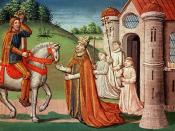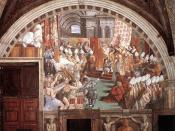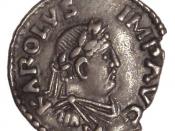As the Roman army ranks were overwhelmed by the intrusion of the Germanic Barbarians, the Roman Army eventually became "barbarianized" and the end of the heavy infantryman. It is, however, ironic that as the Roman Legionnaire evolved from the large rectangular shield and the heavy shorter sax of a foot soldier to the specialized units (with more and more emphasis on the horse), that the Germans and Franks were still "essentially a people of the forest, which precluded the extensive use of cavalry" (Beeler 8). The Franks were basically a light-armed infantry based army--with no armor, small oval shields, and a mixture of arms that included swords, javelins, and franciscas--that still relied upon wild unorganized rushes or the antiquated defensive phalanx for victory.
It was through the Frankish system of requiring armed service to the king that led to the eventual rise and dominance of the mounted soldier. As the basis of the Frankish army relied upon the landwehr for its masses, it was the evolution of the mounted soldier into the elite warrior that led to the overall change in Frankish warfare and armament.
At first these mounted soldiers were better armored, and possibly rode into battle (therefore increasing mobility) and then dismounted to actually commence fighting. However, it was the introduction of the stirrup to the Frankish army that transformed the Frankish horsemen into the master of the European battlefield.
Through the use of the stirrup, a knight could "strap" in to deliver a more powerful thrust with a lance or he could securely "stand up" while astride the horse to deliver a more powerful, downward blow with his sword. The stirrup was also invaluable at keeping the horseman seated in his saddle, and this combination of mobility, armor, armament, and stability quickly secured the advantage that the...



Interesting...
One thing i find reyally interesting in this essay is the fact that in each of the societies listed above we notice that they develop a revolutanary system of warfare as a necessity, they succeed and they they forget about their enemy, i.e once they develop a great system of warfare with which they defeat their enemy they tend to hold on to that same system of warfare, developing it more and more, they forget the fact that you need to keep on developing new things to stay on top of your enemy, and if you have only one system of warfare you enemy finds it's achelley's foot.
9 out of 9 people found this comment useful.